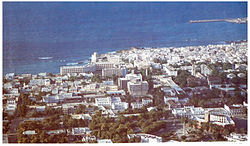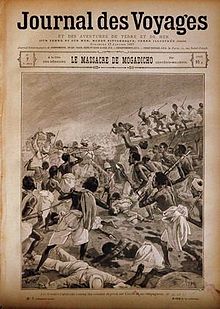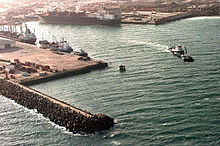Mogadishu
| Muqdisho مقديشو Mogadishu |
||
|---|---|---|
|
|
||
| Coordinates | 2 ° 2 ′ N , 45 ° 20 ′ E | |
| Basic data | ||
| Country | Somalia | |
| Banaadir | ||
| ISO 3166-2 | SO-BN | |
| Residents | 1,977,000 (2017) | |
| politics | ||
| mayor | Omar Mohamud Mohamed | |
|
View over the city, 1980
|
||
Mogadishu [ mogaˈdɪʃu ] ( English Mogadishu , Somali Muqdisho [ mʊɢˈdiːʃoː ], Italian and Swiss German Mogadiscio , Arabic مقديشو, DMG Maqadīšū ), also known under the name Hamar (somali Xamar ), is the capital of Somalia . Mogadishu used to be known as the pearl of East Africa .
location
The city is located in southern Somalia, on the Benadir Coast on the Indian Ocean , around 200 kilometers north of the equator . It is also the capital of the administrative region of Banaadir (Benadir). The neighboring regions Shabeellaha Hoose and Shabeellaha Dhexe used to belong to this, and since their separation, Banaadir has roughly coincided with the urban area of Mogadishu.
climate
| Mogadishu | ||||||||||||||||||||||||||||||||||||||||||||||||
|---|---|---|---|---|---|---|---|---|---|---|---|---|---|---|---|---|---|---|---|---|---|---|---|---|---|---|---|---|---|---|---|---|---|---|---|---|---|---|---|---|---|---|---|---|---|---|---|---|
| Climate diagram | ||||||||||||||||||||||||||||||||||||||||||||||||
| ||||||||||||||||||||||||||||||||||||||||||||||||
|
Average monthly temperatures and rainfall for Mogadishu
Source: BBC Weather ; wetterkontor.de
|
|||||||||||||||||||||||||||||||||||||||||||||||||||||||||||||||||||||||||||||||||||||||||||||||||||||||||||||||||||||||||||||||||||||||||||||||||||||||||||||||||||||||||||||||||||||||||||||||||||
population
Mogadishu has been the largest city in Somalia in recent years with a population of over a million. The exact current population can only be roughly estimated, as no current censuses exist and extensive refugee and migration movements have taken place within Somalia.
In 1975 the city had about 380,000 inhabitants according to the first official census, which was 52% of the nationwide "non-agricultural" (urban) population. Traditionally, the dominant Mogadishu the Somali - Clan of Abgal- Hawiye and the minority of the Reer Hamar (Benadiri). Members of various other clans from other parts of the country have joined them in recent decades.
Since the beginning of the civil war, Mogadishu has gained significantly in influence in the course of the fighting between the Abgal Ali Mahdi Mohammed and the Habar-Gedir-Hawiye Aidid , and numerous Habar Gedir moved into the city, while Darod - the belonged to the same clan as the dictator Siad Barre , who was expelled in 1991 , and were in part the target of acts of revenge by the Hawiye - left the city. Overall, Mogadishu has continued to grow since the beginning of the civil war due to immigrants and internally displaced persons from other parts of the country. For 2005 the population was estimated at around 1.23 million (2.59 million in the agglomeration ; as of January 1, 2005). Current estimates are at 1.58 million inhabitants. The UN estimates the population for 2017 at 1.98 million. According to forecasts, 6.6 million people will live in the agglomeration in 2050.
An estimated 600,000 residents left the city in 2007 after fierce fighting. Most of them fled to the surrounding area ( Middle and Lower Shabeelle ), and some to more distant parts of the country. According to eyewitness reports, only a few apartment blocks in the city center and near the presidential residence Villa Somalia are still regularly inhabited.
Population development according to the UN
| year | population |
|---|---|
| 1950 | 50,000 |
| 1960 | 94,000 |
| 1970 | 256,000 |
| 1980 | 551,000 |
| 1990 | 1,035,000 |
| 2000 | 1,201,000 |
| 2010 | 1,353,000 |
| 2017 | 1,977,000 |
history
The name Mogadishus is said to come either from the Persian maqad shah ("seat of the Shah ") or a mispronunciation of mui wa misho ( Swahili for "northernmost city", which refers to Mogadishu as the northernmost of the Swahili city-states on the East African coast) .
Mogadishu was settled by Arab colonists in the 10th century . Many immigrants came from the Arabian Peninsula , its relative prosperity strengthened it economically, and intercultural marriages with the native Somali quickly ensured the spread of prosperity. At that time the city profited greatly from domestic trade. The Benadiri (Reer Hamar) emerged from the immigrants .
The Fakr-ad-Din Mosque , built in 1269, is one of the oldest Islamic structures in Africa. In 1331 the traveler Ibn Battuta visited Mogadishu and described the city as very large.
In 1416 an ambassador was sent to China , who was brought back by Admiral Zheng He's fleet in 1417 .
In the 16th century, Mogadishu was under Portuguese rule. In 1828 the city submitted to the supremacy of the Sultanate of Oman and from 1856 to the Sultanate of Zanzibar after an Omani fleet bombed the city. Until the stationing of a garrison and the appointment of a governor in 1874, the sultanate had little influence. In 1892 the city was leased to Italy . On November 26, 1896, the Italian consul general Antonio Cecchi was murdered by Somali. In 1905 the area was bought up by Italy and Mogadishu became the capital of the Italian Somaliland colony .
During World War II the city was finally in 1941 after heavy fighting from the direction of Kenya advancing British conquered troops, Italian Somaliland came under British military administration and was 1950-1960 UN - trust territory . In 1960 Mogadishu became the capital of the now independent Somalia.
On January 21, 1904, the Apostolic Prefecture of Banaadir was established in what was then Italian Somaliland with its seat in Mogadishu, which was elevated to the Apostolic Vicariate on December 15, 1927 and was named Mogadiscio. On November 20, 1975, the Vicariate Apostolic of Mogadishu was elevated to a diocese . After the destruction of the cathedral with the adjoining monastery, the diocese virtually dissolved in the civil war.
In the 1970s, the Mosque of Islamic Solidarity was opened.
On the night of 17 to 18 October 1977, the elite unit freed GSG 9 of the Federal Border Police at the airport Mogadishu the hijacked Lufthansa plane Landshut .
Civil war
See also: Somali Civil War
In 1991 rebels from the United Somali Congress (USC) of the Hawiye Clan, who had surrounded the city, forced the escape of the president and dictator Siad Barre from Mogadishu. Subsequently, the capital became the scene of fierce fighting between the two USC leaders Ali Mahdi Mohammed and Mohammed Farah Aidid , who both claimed the presidency. Ali Mahdi controlled the north, Aidid the southern part of the city.
From 1992 the United Nations tried to secure supplies for the population and restore peace as part of the UNOSOM mission. With increasing difficulties, the mission was placed under the leadership of the USA at the end of 1992 ( UNITAF ). On October 3, 1993, the battle of Mogadishu between US soldiers and local militias occurred with high casualties on both sides. After this event, the mission was soon ended without reaching a political solution.
Since then, Mogadishu has been controlled by warlords, clans and their militias who have repeatedly fought without a central city government. For security reasons, Somalia's transitional government, formed after the peace talks in 2000, was unable to move into Mogadishu, but had to move first to Kenyan exile and, from 2005, to the provincial town of Baidoa .
In July 2006, the Union of Islamic Courts brought the city completely under their control and drove out the warlords who were temporarily united in the ARPCT . Gun violence ceased under their rule, but fighting continued in the rest of the country.
In December 2006, the transitional government with massive military support from Ethiopia succeeded in taking Mogadishu and ousting the Union of Islamic Courts. The transitional government tried for the first time to establish itself in Mogadishu and the rest of the country. Former warlord Mohamed Omar Habeb Dhere has been appointed mayor.
In 2007 and 2008, however, Mogadishu saw the heaviest fighting in 15 years between troops loyal to the government and their opponents. Among the latter are militant Islamists and members of the Hawiye clan - some of whom have demanded the immediate withdrawal of Ethiopia, while others pursue more far-reaching political goals - as well as actors who generally have no interest in a stable government. In March / April, July / August (during the National Reconciliation Conference , which produced modest results) and November 2007, violent clashes broke out that displaced around 600,000 people and left thousands dead and injured. A Human Rights Watch report found that the Ethiopian and interim government forces, as well as the insurgents, committed war crimes by acting without consideration for civilians . Even after the withdrawal of the Ethiopian troops and the election of the moderate Islamist Sharif Sheikh Ahmed as the new president at the beginning of 2009, heavy fighting continued ( see also: Battles in Mogadishu since 2010 ).
Mohamoud Ahmed Nur was mayor of Mogadishu from autumn 2010 to February 2014 . He was followed by Hassan Mohamed Hussein (also Mungab ) who was replaced by Yusuf Hassan Jimale in November 2015 .
In an attack in Mogadishu on October 14, 2017 , a suicide bomber killed 358 people in a truck loaded with explosives. 228 people were injured, 56 are still missing (as of October 20, 2017). The Islamist al-Shabaab militia is believed to be behind the terrorist attack . On July 25, 2019, the city's mayor, Abdirahman Omar Osman, was so badly injured in an attack by al-Shabaab that he died shortly afterwards; another six people were killed in the attack.
Economy and Infrastructure
Mogadishu is the economic center of Somalia. On the largest market in Somalia, the Bakara market , in addition to various everyday goods, weapons can also be traded uncontrolled.
The most important industries are the food, beverage and textile industries.
Mogadishu has a sea port. It was closed from 1995 to 2006 until the Union of Islamic Courts reopened it after it came to power. Instead, goods from all over the world were imported via the informal port of El Ma'an and from there, in some cases, via Mogadishu and Somalia to other parts of Africa. In September 2014, the Somali federal government signed a lease agreement with the Turkish conglomerate Albayrak Holding to manage the port of Mogadishu. Accordingly, the company receives 45 percent of the profit, 55 percent gets the Somali state. The contract term is 20 years.
Mogadishu Airport, which was closed during the civil war until 2006, is located southwest of the city . Somalis in exile have been returning to Mogadishu since the end of 2011 and the city is experiencing an economic boom.
sons and daughters of the town
- Only Hassan Hussein (1938–2020), Prime Minister from 2007 to 2009
- Ali Mohammed Ghedi (* 1952), Prime Minister from 2004 to 2007
- Iman Abdulmajid (* 1955), photo model
- Mohamed Abdullahi Mohamed (* 1962), Acting Prime Minister
- Ayaan Hirsi Ali (* 1969), Islam critic and women's rights activist
- Alexander Graf von Schönburg-Glauchau (* 1969), journalist and writer
- Yasmin Warsame (* 1976), photo model
- K'naan (* 1978), musician
- Mustafa Mohamed (* 1979), athlete
- Ilhan Omar (* 1982), American politician
- Mohammed Farah (* 1983), athlete
- Abdisamad Mohamed (* 1985), Counter-Strike player
- George Elokobi (* 1986), football player
- Ayub Daud (* 1990), soccer player
- Abdisalam Ibrahim (* 1991), football player
- Sharif Sheikh Ahmed (* 1964), President from 2009 to 2012
- Barkhad Abdi (* 1985), film actor and BAFTA award winner.
Town twinning
Mogadishu has had a partnership with the Turkish capital Ankara since 2000 .
See also
literature
- Ross E. Dunn: The Adventures of Ibn Battuta , Berkeley 1986. ISBN 0-520-24385-4 .
- Allah's cleaning crew . In: Der Spiegel . No. 32 , 2006 ( online ).
Web links
Individual evidence
- ↑ Countrystudies.us: Somalia - Population
- ↑ bevölkerungsstatistik.de ( Memento from February 12, 2013 in the web archive archive.today )
- ↑ City population 2050 | Sustainability Today. Retrieved July 24, 2018 .
- ↑ BBC News: 'One million' homeless in Somalia
- ↑ Der Spiegel: Ghost Town of Horror
- ↑ World Urbanization Prospects - Population Division - United Nations. Retrieved July 23, 2018 .
- ^ Andreas Birken: The Sultanate of Zanzibar in the 19th century. Stuttgart 1971. p. 160.
- ↑ Italian Mogadiscio (en)
- ^ Lutz Hachmeister: Schleyer. A German story . Munich 2004, pp. 389-394.
- ↑ Der Spiegel Online: Somalia: No Peace in Sight
- ↑ Somalia: Profiting from misery ( Memento from June 2, 2009 in the Internet Archive )
- ^ Human Rights Watch: Somalia: War Crimes in Mogadishu
- ↑ Shafi'i Mohyaddin: President Hassan appoints new mayor of Mogadishu. In: Hiiraan Online. February 28, 2014, accessed October 27, 2015 .
- ^ The mayor of Mogadiscio has been deposed
- ↑ Somali attack death toll rises to 358. In: sueddeutsche.de. Retrieved October 25, 2017 .
- ↑ Bloodbath shakes Mogadiscio. In: nzz.ch. Retrieved October 25, 2017 .
- ↑ Suicide bomber kills six in attack on Mogadishu mayor's office. In: BBC. Retrieved October 25, 2017 .
- ↑ ; Mohamed Olad Hassan: Mogadishu mayor dies of wounds sustained in Al-Shabab attack. voanews.com dated August 1, 2019, accessed August 2, 2019
- ↑ UN World Food Program: "For the first time in ten years, WFP ship docks with food in Mogadishu - in the past there have been repeated pirate attacks"
- ↑ brandeins.de: A country without a state: Somalia ( Memento of the original from November 3, 2013 in the Internet Archive ) Info: The archive link was automatically inserted and not yet checked. Please check the original and archive link according to the instructions and then remove this notice. (Report on the economy in Mogadishu / Somalia, 2005)
- ↑ Albayrak Holding website , accessed February 5, 2017
- ↑ Jeffrey Gettleman: A Taste of Hope in Somalia's Battered Capital. , nytimes.com of April 3, 2012, accessed March 15, 2013
- ↑ Ankara Büyükşehir Belediyesi Kardeş - Ankaranın Şehirleri , accessed on November 8, 2013.






